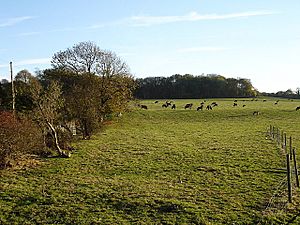Queendown Warren facts for kids
| Site of Special Scientific Interest | |
 |
|
| Area of Search | Kent |
|---|---|
| Interest | Biological |
| Area | 22.2 hectares (55 acres) |
| Notification | 1983 |
| Location map | Magic Map |
Queendown Warren is a special natural area in Kent, England. It's located south-east of Rainham. This amazing place is about 22.2 hectares (55 acres) in size, which is like having 55 football fields! It's officially known as a Site of Special Scientific Interest because of its important plants and animals.
Queendown Warren is also a Local Nature Reserve, which means it's protected for nature. It's part of the beautiful Kent Downs Area of Outstanding Natural Beauty. The Kent Wildlife Trust helps look after this wonderful place.
A Look Back at Queendown Warren's History
This nature reserve is quite large, covering almost 80 hectares (198 acres) in total. It's made up of a few different parts. The oldest part of the reserve used to be a "rabbit warren" a long, long time ago, back in the Middle Ages. This means it was a place where rabbits were raised for food.
This main part of the reserve has probably been open grassland for hundreds of years. It's super important because it has a special collection of grassland orchids that are known around the world!
In 1999, the reserve grew bigger when some pasture land was added. This new area is being carefully managed to help new plants and animals from the original reserve move in. Then, in 2003, another 40 hectares (99 acres) of farmland was added. This doubled the size of the reserve! Over time, this new land will also become a great home for wildlife.
Discover the Plants and Animals of Queendown Warren
Queendown Warren is famous for its chalk grassland plants. You'll find many types of beautiful orchids here! Look out for the fragrant orchid, and you might also spot early spider, bee, and man orchids. Later in the year, you could find autumn lady's-tresses.
In summer, many different kinds of butterflies fly around. You might see the Adonis Blue butterfly, which was brought back to the area in 2002. At the bottom of the main hill, there are lots of rabbits. These rabbits, along with cows that graze, help keep the grass short. This short grass is very important for many orchid plants to grow well.
On the West Bank, you can find patches of fly orchid and white helleborine. These grow near the edges of the woods and bushes. This part of the reserve also has some really big and old beech trees.
Potters Wood is another part of the reserve. It has native trees like oak, ash, beech, birch, and wild cherry. There's also some sweet chestnut trees that are managed using old, traditional methods. The southern part of the wood is on chalky ground. It still has parts of many large beech trees that fell during a big storm in 1987. This area is also a good place to try and spot adders, which are a type of snake.
How to Visit Queendown Warren
You can easily get to Queendown Warren from Warren Lane. This lane actually goes right through the middle of the site, making it easy to explore.

